
Bratislava: The Heart of Slovakia
Discover Bratislava: Slovakia's enchanting capital, where medieval history meets modern culture along the scenic Danube River.
Bratislava, the capital of Slovakia, is a city where history and modernity blend seamlessly. Nestled along the banks of the Danube River, it offers a picturesque setting with a backdrop of the Little Carpathian mountains. The city's compact size makes it easy to explore on foot, allowing tourists to soak in its charming, cobblestone streets and vibrant squares. Start your journey in the Old Town, where medieval towers and grand palaces tell tales of a rich past. Don't miss the iconic Bratislava Castle, perched high above the city, offering panoramic views that stretch into neighboring Austria and Hungary. The castle's museum provides a deep dive into Slovakia's history and culture, while the lush gardens surrounding it are perfect for a relaxed stroll. Bratislava is also a hub of contemporary culture. The Slovak National Theatre and the Slovak Philharmonic offer world-class performances, and the city's art galleries showcase a range of works from classical to modern. For a taste of local life, visit one of the many cafés and restaurants serving traditional Slovak cuisine, such as bryndzové halušky (potato dumplings with sheep cheese) and locally brewed beers. The city's location makes it an ideal base for day trips to nearby attractions. Head to the Devin Castle ruins for a glimpse of ancient history or explore the scenic vineyards of the Small Carpathians Wine Region. Whether you're a history buff, a culture enthusiast, or just looking for a scenic getaway, Bratislava has something to offer every traveler.
Local tips in Bratislava
- Explore the Old Town by foot to truly appreciate its charm and hidden gems.
- Visit Bratislava Castle early in the morning to avoid the crowds and enjoy the best views.
- Try traditional Slovak dishes at local restaurants for an authentic culinary experience.
- Take a day trip to Devin Castle for stunning views and historical insights.
- Use public transport, which is efficient and connects all major attractions.
- Don't miss the Blue Church, an architectural gem just a short walk from the city center.
Neighbourhoods in Bratislava
Bratislava: The Heart of Slovakia
Bratislava, the capital of Slovakia, is a city where history and modernity blend seamlessly. Nestled along the banks of the Danube River, it offers a picturesque setting with a backdrop of the Little Carpathian mountains. The city's compact size makes it easy to explore on foot, allowing tourists to soak in its charming, cobblestone streets and vibrant squares. Start your journey in the Old Town, where medieval towers and grand palaces tell tales of a rich past. Don't miss the iconic Bratislava Castle, perched high above the city, offering panoramic views that stretch into neighboring Austria and Hungary. The castle's museum provides a deep dive into Slovakia's history and culture, while the lush gardens surrounding it are perfect for a relaxed stroll. Bratislava is also a hub of contemporary culture. The Slovak National Theatre and the Slovak Philharmonic offer world-class performances, and the city's art galleries showcase a range of works from classical to modern. For a taste of local life, visit one of the many cafés and restaurants serving traditional Slovak cuisine, such as bryndzové halušky (potato dumplings with sheep cheese) and locally brewed beers. The city's location makes it an ideal base for day trips to nearby attractions. Head to the Devin Castle ruins for a glimpse of ancient history or explore the scenic vineyards of the Small Carpathians Wine Region. Whether you're a history buff, a culture enthusiast, or just looking for a scenic getaway, Bratislava has something to offer every traveler.
When is the best time to go to Bratislava?
Iconic landmarks you can’t miss
Bratislava Castle
Discover the stunning Bratislava Castle, a historic landmark perched above the Danube, blending rich culture with breathtaking views in Slovakia's capital.

Hrad Devín
Explore Hrad Devín, a historic castle offering breathtaking views and a journey through Slovakia's rich heritage at the confluence of two rivers.

Michael's Gate
Explore Michael's Gate, a historic landmark in Bratislava's Old Town, offering a glimpse into the city's medieval past and stunning architectural beauty.

Čumil
Explore Cumil, the whimsical statue of Bratislava, a beloved cultural icon that offers laughter and photo opportunities in the heart of Slovakia's capital.

Slavín
Explore the majestic Slavín war memorial in Bratislava, a tribute to history with breathtaking views and serene gardens.

Most SNP (UFO Tower)
Discover breathtaking views of Bratislava and the Danube from the iconic UFO Tower, a must-visit observation deck and dining experience.

St. Martin's Cathedral
Explore the majestic St. Martin's Cathedral in Bratislava, a stunning Gothic monument rich in history and architectural beauty.

Hviezdoslavovo námestie
Experience the vibrant atmosphere and rich history of Hviezdoslavovo Námestie, Bratislava's enchanting city park and cultural hub.

Primacial Palace
Explore the grandeur of Primacial Palace in Bratislava, a historical landmark showcasing exquisite architecture and rich cultural heritage.

Presidential Palace
Discover the stunning Presidential Palace in Bratislava, a blend of history and architectural beauty with lush gardens and cultural significance.

Presidential Garden
Explore the lush landscapes and rich history of Bratislava's Presidential Garden, a serene retreat amidst the city's charm.

Old Bridge
Explore the historical Old Bridge in Bratislava, an iconic landmark offering stunning views of the Danube and the city's vibrant atmosphere.

Maximilian's fountain
Experience the historic charm of Maximilian's Fountain in Bratislava's Old Town, a must-visit landmark blending art, culture, and vibrant city life.

Slovak National Theatre (Historical Building)
Discover the Slovak National Theatre in Bratislava, a stunning venue showcasing the best of Slovak performing arts and rich cultural heritage.
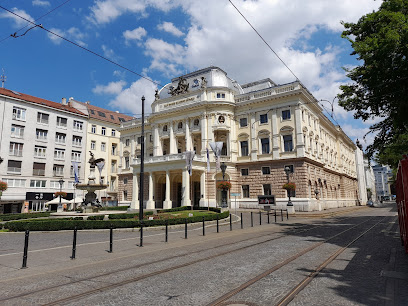
Gallery Multium
Explore contemporary art and vibrant exhibitions at Gallery Multium, a must-visit destination for art enthusiasts in Bratislava-Hrad.
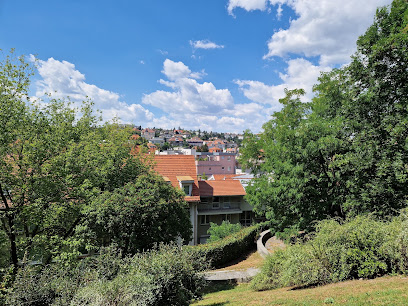
Unmissable attractions to see
Bratislava Castle
Discover the rich history and stunning views at Bratislava Castle, Slovakia's iconic landmark that overlooks the beautiful cityscape.

Hrad Devín
Discover the rich history and breathtaking views of Hrad Devín, a stunning castle overlooking the confluence of the Morava and Danube rivers in Slovakia.

Michael's Gate
Explore the historical charm of Michael's Gate in Old Town, Bratislava - a majestic symbol of the city's rich heritage and architectural splendor.

Čumil
Experience the charm of Bratislava at Cumil, the quirky bronze statue that symbolizes the city's playful spirit and rich cultural history.

The Blue Church - Church of St. Elizabeth
Explore the stunning Blue Church of St. Elizabeth in Bratislava, a masterpiece of Art Nouveau architecture and a serene place of worship.

Slavín
Explore the profound history and breathtaking views at Slavín Memorial, a tribute to the heroes of World War II in Old Town.

Most SNP (UFO Tower)
Discover breathtaking views and modern architecture at the UFO Tower, Bratislava's iconic observation deck overlooking the stunning Danube River.

Schloss Hof
Explore the elegant Schloss Hof, a stunning baroque castle in Austria, showcasing historical treasures, beautiful gardens, and rich cultural heritage.

St. Martin's Cathedral
Explore the stunning St. Martin's Cathedral in Bratislava, a magnificent Gothic architectural gem and a symbol of Slovakia's rich history.

Slovak National Theatre
Discover the artistic heart of Slovakia at the Slovak National Theatre, where captivating performances and rich history unite in a stunning setting.

Smolenický castle
Explore the stunning Smolenický Castle, a historic gem nestled in the heart of Slovakia, offering breathtaking views and rich cultural experiences.

Hviezdoslavovo námestie
Discover the cultural heart of Bratislava at Hviezdoslavovo Námestie, a vibrant square adorned with stunning architecture and lively cafes.

Danubiana Meulensteen Art Museum
Explore contemporary art and stunning river views at the Danubiana Meulensteen Art Museum in Bratislava, a premier destination for art lovers.
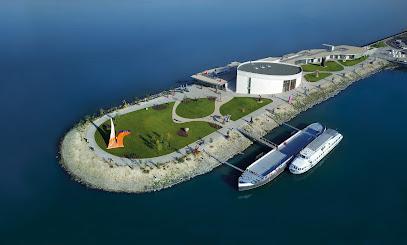
Römerstadt Carnuntum
Experience the grandeur of the Roman Empire at Römerstadt Carnuntum, an unforgettable open-air museum in Austria showcasing ancient history.

Primacial Palace
Discover the elegant Primacial Palace in Bratislava, an architectural gem and historical landmark showcasing the rich heritage of Slovakia.

Essential places to dine
Slovak Pub
Experience authentic Slovak cuisine in a lively atmosphere at Slovak Pub in Bratislava – where tradition meets taste.

Bratislava Flagship
Experience authentic Slovak cuisine at Bratislava Flagship, where history meets culinary artistry in a vibrant setting.

Bratislavský Meštiansky Pivovar
Discover the best of Slovakian brewing culture at Bratislavský Meštiansky Pivovar – where tradition meets taste.

Roxor
Experience gourmet hamburgers at Roxor in Bratislava – where quality meets flavor in every bite.

UFO
Discover Bratislava's iconic UFO restaurant for stunning views and exceptional cuisine overlooking the Danube River.

Urban House
Discover Urban House in Bratislava: where modern dining meets exceptional burgers and an inviting atmosphere.

Gatto Matto Panská
Discover Gatto Matto Panská: where authentic Italian flavors meet fresh seafood delights in the heart of Old Town.

Bistro Zepen House
Discover authentic Georgian and Ukrainian cuisine at Bistro Zepen House in Bratislava - where flavor meets tradition.

FABRIKA the beer pub
Discover FABRIKA the Beer Pub: A vibrant brewpub in Old Town serving authentic Slovak cuisine paired with exquisite local beers.

Reštaurácia Divný Janko
Experience authentic Slovak cuisine at Reštaurácia Divný Janko in Old Town Bratislava—where tradition meets taste in every bite.

Koliba Kamzík Zelená
Discover the essence of Slovak cuisine at Koliba Kamzík Zelená - where tradition meets taste in a charming setting.

Lemontree & Sky Bar Restaurant Bratislava
Discover exquisite modern European cuisine and stunning skyline views at Lemontree & Sky Bar in Bratislava's vibrant atmosphere.

Balans Bistro
Discover the vibrant flavors of plant-based cuisine at Balans Bistro in Bratislava - where health meets creativity.

Urban Bistro
Discover Urban Bistro in Bratislava: A delightful bistro offering scrumptious breakfasts and cozy meals in an inviting atmosphere.

FACH
Discover FACH in Bratislava: A delightful bistro offering vegan dishes and artisanal baked goods in a cozy setting.

Markets, malls and hidden boutiques
Aupark Bratislava
Discover the ultimate shopping and entertainment experience at Aupark Bratislava, featuring a diverse range of stores, dining, and fun for all ages.
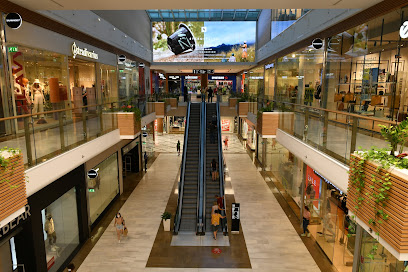
Eurovea
Discover Eurovea, Bratislava's premier shopping destination offering luxury brands, diverse dining, and stunning riverside views.

AVION Shopping Park Bratislava
Discover a shopper's haven at AVION Shopping Park Bratislava, featuring top brands, dining delights, and entertainment options in a vibrant atmosphere.

Flying Tiger Copenhagen
Explore Flying Tiger Copenhagen in Bratislava for quirky gifts, unique home goods, and fun accessories that bring joy to every visitor.
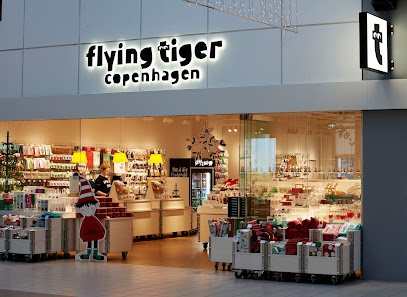
Hublot Bratislava Boutique
Discover the elegance of Swiss watchmaking at Hublot Bratislava Boutique, where luxury meets craftsmanship in the heart of Slovakia.

RoofTop s.r.o. - Urban Fine art, Graffiti & Headshop
Discover RoofTop s.r.o. – a unique department store blending art supplies with urban culture in the heart of Old Town.

Medový obchod CERA MEL
Discover the essence of Slovak culture through honey products and local crafts at Medový obchod CERA MEL in Bratislava.

The Oldest shop in town
Discover the charm of history at the Oldest Shop in Town, a unique gift shop and museum offering local treats and souvenirs for every traveler.

Vintage Shop
Explore the charm of vintage fashion in Bratislava at this unique clothing store, where every piece has a story to tell.

NOSENE
Explore NOSENE in Bratislava for a sustainable shopping experience, featuring unique second-hand clothing and eco-friendly beauty supplies.

City Gate
Explore City Gate: Bratislava's premier shopping mall featuring a diverse range of shops, dining, and entertainment options for an unforgettable experience.

PLACE STORE design concept store
Explore PLACE STORE in Bratislava: A Design Concept Shop Where Unique Creations Meet Local Artistry.
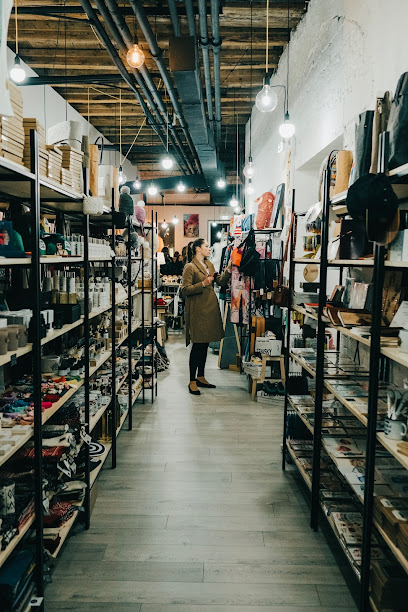
Genesis Second Hand
Explore sustainable fashion treasures at Genesis Second Hand in Bratislava, where every piece has a story waiting to be discovered.

Antikvariát Steiner
Discover rare books and collectibles at Antikvariát Steiner, a charming used book store in Old Town, Bratislava.

Souvenirs Klarisky
Explore the heart of Old Town at Souvenirs Klarisky, where unique treasures and local artistry await every traveler.

Essential bars & hidden hideouts
Slovak Pub
Discover the heart of Slovak cuisine at Slovak Pub, a vibrant dining spot in Bratislava offering traditional dishes and local beers.

The Dubliner Irish Pub
Discover the lively spirit of Ireland at The Dubliner Irish Pub in Old Town: a cozy haven for great food, drinks, and entertainment.

FABRIKA the beer pub
Discover FABRIKA the Beer Pub, a brewpub in Bratislava's Old Town offering craft beers and authentic Slovak cuisine for an unforgettable experience.

17’s BAR
Experience the best of Bratislava's pub culture at 17’s BAR, where delicious burgers, artisan pizzas, and craft beers await you.

Bukowski Bar
Discover the eclectic charm and vibrant nightlife of Bukowski Bar in Bratislava, where every sip tells a story.

Dungeon Pub
Experience the enchanting atmosphere of Dungeon Pub in Bratislava, where fantasy meets fun with a vast selection of drinks and a unique medieval decor.

Goblins Pub
Discover Goblins Pub: Bratislava's hidden gem for live music and comedy in an enchanting underground setting.
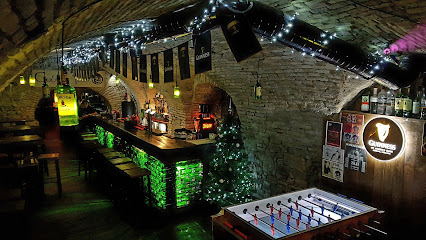
Žil Verne craftbeer pub
Discover the essence of Slovak brewing culture at Žil Verne craftbeer pub in Bratislava, where every sip tells a story.

Zbrojnoš pub
Discover the lively ambiance and authentic local flavors at Zbrojnoš Pub in Old Town, an essential stop for every traveler.

Michalska Cocktail Room
Unwind at Michalska Cocktail Room, Bratislava's premier cocktail bar, where creativity meets quality in every handcrafted drink.

Baudelaire Bar
Discover Baudelaire Bar in Bratislava – the perfect blend of cozy atmosphere, unique cocktails, and vibrant nightlife.

VRBA - Virtual Reality Gin&Tonic Bar
Explore the fusion of virtual reality and exquisite cocktails at VRBA, Bratislava's premier Gin&Tonic bar for an unforgettable night out.

Old Fashioned Bar
Immerse yourself in the vintage ambiance of Old Fashioned Bar, a cocktail haven in Bratislava with expertly crafted drinks and a unique speakeasy feel.

Nu Spirit Bar
Discover Nu Spirit Bar in Old Town: A vibrant hotspot for cocktails, live music, and unforgettable nightlife experiences in the heart of the city.

The Peach
Experience the vibrant atmosphere of The Peach in Bratislava, where exceptional drinks, delicious bites, and a warm ambiance create unforgettable moments.

Local Phrases
-
- HelloAhoj
[ahoy] - GoodbyeDovidenia
[doh-vee-de-nyah] - YesÁno
[ah-noh] - NoNie
[nye] - Please/You're welcomeProsím
[pro-seem] - Thank youĎakujem
[dyah-koo-yem] - Excuse me/SorryPrepáčte
[pre-pahch-te] - How are you?Ako sa máš?
[ah-ko sa mah-sh] - Fine. And you?Dobre. A ty?
[doh-bre. ah tee] - Do you speak English?Hovoríte po anglicky?
[ho-vo-ree-teh poh ahng-leet-skee] - I don't understandNerozumiem
[neh-roh-zoo-mee-em]
- HelloAhoj
-
- I'd like to see the menu, pleaseChcel by som vidieť menu, prosím
[khel bih som vee-dyecht meh-noo, pro-seem] - I don't eat meatNejedám mäso
[neh-yeh-dahm mah-soh] - Cheers!Na zdravie!
[nah zdrah-vee-eh] - I would like to pay, pleaseChcel by som zaplatiť, prosím
[khel bih som zah-pla-teet, pro-seem]
- I'd like to see the menu, pleaseChcel by som vidieť menu, prosím
-
- Help!Pomoc!
[poh-mohts] - Go away!Choď preč!
[khoy prech] - Call the Police!Volaj políciu!
[voh-lai poh-lee-tsyou] - Call a doctor!Volajte lekára!
[voh-lai-te leh-ka-rah] - I'm lostZablúdil som
[zah-bloo-deel som] - I'm illSom chorý
[somm khor-ee]
- Help!Pomoc!
-
- I'd like to buy...Chcel by som kúpiť...
[khel bih som koo-peet] - I'm just lookingLen sa pozerám
[len sa po-ze-rahm] - How much is it?Koľko to stojí?
[kohl-koh toh stoh-yee] - That's too expensiveTo je príliš drahé
[toh yeh pree-lish drah-heh] - Can you lower the price?Môžete znížiť cenu?
[moh-zhe-teh znee-zheet tseh-noo]
- I'd like to buy...Chcel by som kúpiť...
-
- What time is it?Koľko je hodín?
[kohl-koh yeh hoh-deen] - It's one o'clockJe jedna hodina
[yeh yehd-nah hoh-dee-nah] - Half past (10)Polovica desiatej
[poh-lo-vee-tsah deh-syah-tey] - MorningRáno
[rah-noh] - AfternoonPopoludní
[poh-poh-loo-dnee] - EveningVečer
[veh-cher] - YesterdayVčera
[vcheh-rah] - TodayDnes
[dnes] - TomorrowZajtra
[zai-tra] - 1Jedna
[yehd-nah] - 2Dva
[dvah] - 3Tri
[tree] - 4Štyri
[shteer-ee] - 5Päť
[pyaht] - 6Šesť
[shest] - 7Sedem
[seh-dem] - 8Osem
[oh-sem] - 9Deväť
[deh-vyat] - 10Desať
[deh-saht]
- What time is it?Koľko je hodín?
-
- Where's a/the...?Kde je...?
[kde yeh] - What's the address?Aká je adresa?
[ah-kah yeh ah-dreh-sah] - Can you show me (on the map)?Môžete mi to ukázať (na mape)?
[moh-zhe-teh mee toh oo-kah-zat (nah mah-peh)] - When's the next (bus)?Kedy je ďalší (autobus)?
[keh-dee yeh dyahl-shee (ow-toh-boos)] - A ticket (to ....)Lístok (do ...)
[lees-tohk (doh)]
- Where's a/the...?Kde je...?
History of Bratislava
-
Bratislava, the capital city of Slovakia, has a rich history dating back to the Neolithic period. Known as Pressburg in German and Pozsony in Hungarian, it became a significant settlement during the Roman period. The strategic location on the Danube River made it an important hub for trade and defense.
-
Bratislava Castle, perched on a hill overlooking the Danube, has been a landmark since the 10th century. The castle played a vital role during the Middle Ages, serving as a royal residence and a defensive stronghold. It was during this period that Bratislava began to flourish as a center of commerce and culture.
-
From the 16th to the 18th century, Bratislava was part of the Habsburg Monarchy. The city gained prominence as the coronation site for Hungarian kings and queens. St. Martin's Cathedral hosted numerous coronations, solidifying Bratislava's status as a key political and cultural center.
-
The 19th century was a period of significant change for Bratislava. The city witnessed the rise of nationalism and the push for reforms. The Hungarian Revolution of 1848-1849 left its mark on Bratislava, leading to social and political transformations. This era also saw the construction of important cultural institutions, such as the Slovak National Theatre.
-
The aftermath of World War I brought about the dissolution of the Austro-Hungarian Empire and the creation of Czechoslovakia in 1918. Bratislava, known as Prešporok at the time, became a part of this new nation. The city underwent significant demographic and cultural shifts, reflecting its new status within Czechoslovakia.
-
During World War II, Bratislava was the capital of the Slovak State, a Nazi puppet regime. The war brought hardship and destruction to the city, including the persecution of Jewish residents. The end of the war saw Bratislava liberated by Soviet forces, leading to the establishment of a socialist government.
-
From 1948 to 1989, Bratislava was under communist rule as part of Czechoslovakia. The city underwent extensive industrialization and urban development. Landmarks such as the SNP Bridge and the Kamzík TV Tower were constructed during this period. The Velvet Revolution of 1989 marked the end of communist rule and paved the way for democratic reforms.
-
On January 1, 1993, Czechoslovakia peacefully split into two countries, and Bratislava became the capital of the newly independent Slovakia. Since then, the city has experienced rapid growth and modernization. Today, Bratislava is a vibrant European capital known for its historical architecture, cultural events, and dynamic economy.
Bratislava Essentials
-
Bratislava is conveniently accessible by various modes of transportation. The city is served by the Bratislava Airport (Letisko M. R. Štefánika), located just about 9 kilometers from the city center. Alternatively, Vienna International Airport is about 60 kilometers away and offers more international flight options. From Vienna, you can reach Bratislava by train, bus, or taxi. Bratislava is also well-connected by train, with direct services from major European cities like Vienna, Budapest, and Prague. Long-distance buses also operate frequently, providing an economical option for travelers.
-
Getting around Bratislava is easy with its efficient public transportation system, which includes buses, trams, and trolleybuses. Tickets can be purchased at kiosks, ticket machines, or via mobile apps. Taxis and ride-sharing services like Uber are available, but it's advisable to use licensed taxi services. The city center is compact and walkable, making it perfect for exploring on foot. For those who prefer cycling, bike rentals and bike-sharing programs are also available.
-
The official currency of Slovakia is the Euro (€). Credit and debit cards are widely accepted in hotels, restaurants, and shops. ATMs are plentiful throughout the city, and it's easy to withdraw cash as needed. However, it's a good idea to carry some cash for smaller establishments and markets where card payments might not be accepted.
-
Bratislava is generally a safe city for tourists. However, like any other city, it's wise to take standard precautions. Avoid poorly lit areas at night and be cautious in crowded places to prevent pickpocketing. Areas such as the Main Train Station and some parts of Petržalka can have higher instances of petty crime, so stay vigilant. Always keep an eye on your belongings and use hotel safes for valuables.
-
In case of emergency, dial 112 for immediate assistance, which covers police, fire, and medical services. Bratislava has several hospitals and clinics that provide emergency medical care. Pharmacies are readily available for minor health issues. It is advisable to have travel insurance that covers medical emergencies. The local police are dependable and can assist with various issues foreign tourists might face.
-
Fashion: Do dress smart-casual, especially in restaurants and theaters. Avoid overly casual clothing like flip-flops and beachwear unless you're at a pool. Religion: Do respect religious customs and dress modestly when visiting churches. Public Transport: Do validate your ticket before boarding and give up your seat to elderly passengers. Don’t eat or drink on public transport. Greetings: Do greet people with a handshake. A friendly 'Ahoj' (Hello) is also common. Eating & Drinking: Do try local dishes like bryndzové halušky and accept food offerings graciously. Don’t forget to tip, usually around 10% in restaurants.
-
To experience Bratislava like a local, spend some time in the old town's hidden cafes and bistros. Visit the local markets such as the Fresh Market and Miletičova Market for fresh produce and traditional foods. Engage with locals who are often friendly and willing to share stories about their city. Don’t miss the outdoor activities along the Danube River, including river cruises and bike paths. For a unique experience, take a walk through the less touristy neighborhoods like the hipster district of Štúrova or the artistic area around the Blue Church.
Trending Landmark in Bratislava
Nearby Cities to Bratislava
-
Things To Do in Trnava
-
Things To Do in Eisenstadt
-
Things To Do in Vienna
-
Things To Do in Sopron
-
Things To Do in Gyor
-
Things To Do in Trenčín
-
Things To Do in Szombathely
-
Things To Do in Tatabanya
-
Things To Do in Brno
-
Things To Do in Veszprem
-
Things To Do in Szekesfehervar
-
Things To Do in Zalaegerszeg
-
Things To Do in Keszthely
-
Things To Do in Vac
-
Things To Do in Olomouc
















